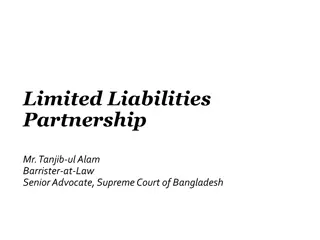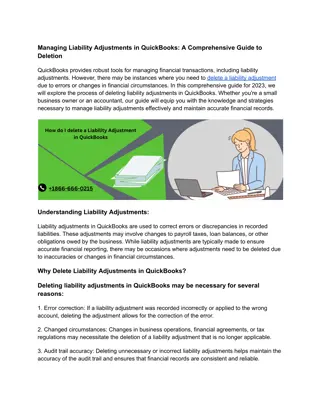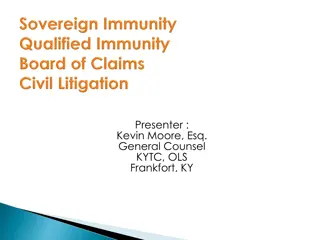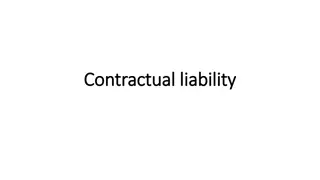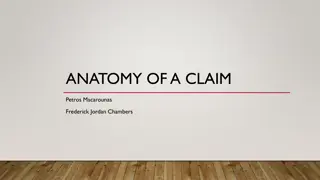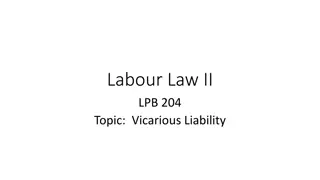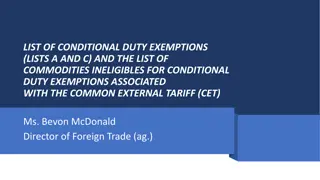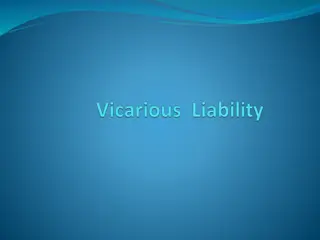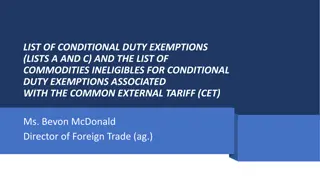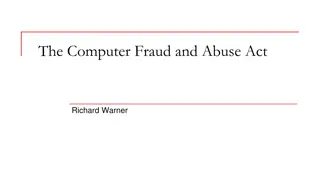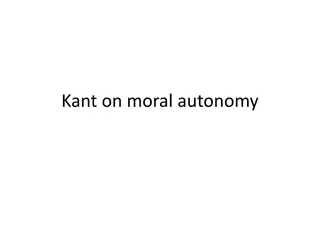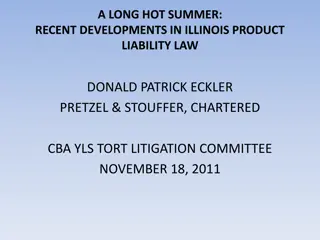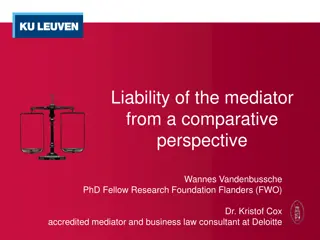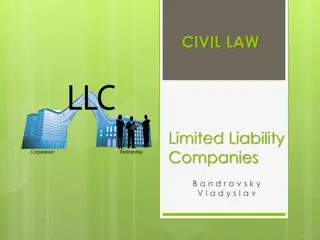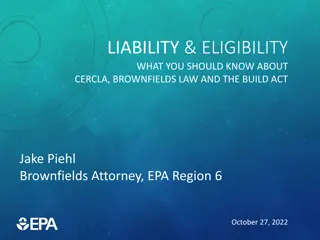Occupiers Liability Act 1984: Duty to Trespassers
Exploring the Occupiers Liability Act 1984 and the duty owed to trespassers, including the definition of an occupier, statutory duties of care, and the historical context of the law's evolution.
Download Presentation

Please find below an Image/Link to download the presentation.
The content on the website is provided AS IS for your information and personal use only. It may not be sold, licensed, or shared on other websites without obtaining consent from the author. Download presentation by click this link. If you encounter any issues during the download, it is possible that the publisher has removed the file from their server.
E N D
Presentation Transcript
Occupiers liability Occupiers Liability Act 1984: Liability in relation to trespassers
Lesson Objectives By the end of the session you should be able to: 1. Explain who is an occupier under the Occupiers Liability Act 1984. 2. Explain when a statutory duty of care is owed. 3. Explain the statutory duty of care that is owed. 4. Explain the difference in the duty owed under the Occupiers Liability Act 1984 with that owed under the Occupiers Liability Act 1957.
Reminder: a Tort Covered by Statute Law Occupier s liability comes from both statute law and the common law. This area of tort involves the liability of an occupier to both visitors and persons other than visitors to his or her premises.
Reminder: The Key Statutes The two key statutes are: 1. The Occupiers Liability Act 1957 which covers visitors 2. The Occupiers Liability Act 1984 which covers persons other than visitors.
Occupiers Liability Act 1984 This presentation is about the Occupiers Liability Act 1984 This act concerns the duty owed to persons other than visitors [A person other than a visitor is often referred is an unlawful visitor or trespasserin many textbooks.]
Who is an Occupier? Anybody who would be classified as an occupier under the Occupiers Liability Act 1957 is an occupier under the Occupiers Liability Act 1984.
Trespassers The common law was very harsh towards trespassers including children. In Addie v Dumbreck [1929] it was held that there was no duty of care owed by occupiers to trespassers to ensure that they were safe when coming onto the land. The only duty was not to inflict harm wilfully.
British Railways Board v Herrington [1972] In British Railways Board v Herrington [1972], the House of Lords used their 1966 Practice Statement and departed from their precedent in Addie v Dumbreck [1929] and held that a duty of care could be owed to trespassers. The decision in this case eventually led to Parliament introducing the Occupiers Liability Act 1984.
Activity Using a textbook or multimedia device, find out the facts of the case and the decision of the House of Lords in: Adie v Dumbreck [1929] British Railways Board v Herrington [1972]
The Statutory Duty of Care Under the Occupiers Liability Act 1984 s1 (3), an occupier of premises owes a statutory duty of care to an unlawful visitor if: (a) he is aware of the danger or has reasonable grounds to believe that it exists; and (b)he knows or has reasonable grounds to believe that the other is in the vicinity of the danger concerned or that he may come into the vicinity of the danger); and (c) the risk is one against which, in all the circumstances of the case, he may reasonably be expected to offer the other some protection.
The Duty Owed Under the Occupiers Liability Act 1984 s1(4) the duty owed to persons other visitors is to take care as is reasonable in all the circumstances of the case to see that they are not injuredon the premises by the danger concerned.
Discussion Question How does the duty imposed under the Occupiers Liability Act 1984 differ from that imposed under the Occupiers Liability Act 1957?
How does the duty imposed under the Occupiers Liability Act 1984 differ from that imposed under the Occupiers Liability Act 1957? Occupiers Liability Act 1957 Occupiers Liability Act 1984 To take such care as is reasonable to see that the visitor will be reasonably safe in using the premises for the purposes for which he is invited or permitted by the occupier to be there. To take care as is reasonable to see that the non- visitor is not injured on the premises by the danger concerned.
How does the duty imposed under the Occupiers Liability Act 1984 differ from that imposed under the Occupiers Liability Act 1957? Lord Hoffman: Parliament has made it clear that in the case of a lawful visitor, one starts from the assumption that there is a duty whereas in the case of a trespasser one starts from the assumption that there is none. Tomlinson v Congleton Borough Council [2003] https://www.publications.parliament.uk/pa/ld200203/ldjudgmt/jd030731/tomlin-1.htm This means that under the Occupiers Liability Act 1957, a duty of care is owed to all visitors whereas under the Occupiers Liability Act 1984 a duty is owed only if certain conditions are met (e.g. the occupier is aware of the danger, etc.).
Tomlinson v Congleton Borough Council [2003] Tomlinson was aged 18. He visited an artificial lake which was part of a country park in Congleton in Cheshire. Canoeing and windsurfing was permitted in one area of the lake and angling in another. Swimming and diving was not permitted. Tomlinson ignored warning signs not to enter the lake ( Dangerous Water. No swimming. ) and dived into it. He hit his head on the bottom, causing him to break his neck which left him a tetraplegic. He brought proceedings against Congleton Borough Council claiming for loss of earnings, loss of quality of life and the cost of the care he would require as a result of his injuries. Was the council liable under the Occupiers Liability Act 1957? Was the council liable under the Occupiers Liability Act 1984?
Tomlinson v Congleton Borough Council [2003] Tomlinson may have been a visitor when he arrived at the lake but it was accepted that he was a trespasser when he entered the water and any successful claims would have to be under the Occupiers Liability Act 1984. Tomlinson was aware that he was not permitted to dive in the lake. Although the council were aware of the danger, they had introduced patrols and warning signs to stop swimming and diving. The House of Lords dismissed Tomlinson s claims.
Tomlinson v Congleton Borough Council [2003] Lord Hoffman: I think it will be extremely rare for an occupier of land to be under a duty to prevent people from taking risks which are inherent in the activities they freely choose to undertake upon the land. If people want to climb mountains, go hang gliding or swim or dive in ponds or lakes, that is their affair. Of course the landowner may for his own reasons wish to prohibit such activities. He may think that they are a danger or inconvenience to himself or others. Or he may take a paternalist view and prefer people not to undertake risky activities on his land. He is entitled to impose such conditions, as the Council did by prohibiting swimming. But the law does not require him to do so.
Tomlinson v Congleton Borough Council [2003] Lord Hoffman: It is unjust that the harmless recreation of responsible parents and children with buckets and spades on the beaches should be prohibited in order to comply with what is thought to be a legal duty to safeguard irresponsible visitors against dangers which are perfectly obvious. The fact that such people take no notice of warnings cannot create a duty to take other steps to protect them. https://www.publications.parliament.uk/pa/ld200203/ldjudgmt/jd030731/tomlin-1.htm
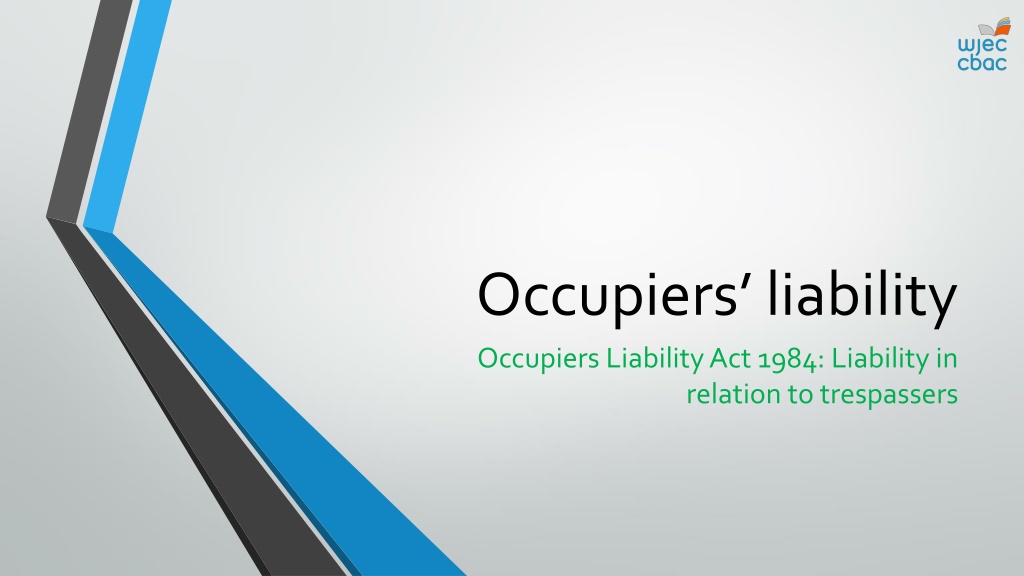
 undefined
undefined






